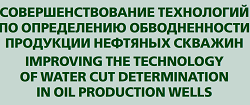- Home page /
- Technologies /
- Our publications about technologies /
- Improving the Technology of Water Cut Determination in Oil...
Improving the Technology of Water Cut Determination in Oil Production Wells
I. DENISLAMOV, A. KAMALTDINOV, G. DENISLAMOVA, Z. MAKSUTOV, Ufa State Petroleum Technological University

Oil well water cut as well as production rate are the most important criteria for well operation and reservoir development. In most cases water cut is the content of water in production fluid that is expressed as a percentage or a fraction. That is why success of well intervention operations is determined by the change in water content in production fluid. There are several methods and technologies of determination of this parameter in oil companies and all these methods are successfully applied. The paper describes collection of production fluid samples of 1–3 m3 volume at the wellhead.
When production fluid is lifted from perforation holes at the reservoir depth to the wellhead equipment, gas-liquid ratio is affected by the change in pressure and temperature along the casing and tubing. That is why wellhead sample taken via standard wellhead sampling tool is not representative, especially in high-water-cut wells.
Inventions consider tubing string with electrical submersible pump as a huge sampling container where production fluid breaks into oil, water and gas. Oil and water remain in tubing while associated gas is slowly discharged through the sampling tool in the lubricator at the wellhead. The technology described in invention was successfully tested in well № 1387 at Tatneft Novo-Yelkhovskoye field. The level of oil-water contact was determined using resistivity meter after 24 hours after ESP stop. This method of water cut determination exhibits high level of veracity but it requires many additional tests, for example tripping of downhole sampling tools. Moreover, the well is out of service for 24 hours that leads to losses of oil production.
According to the invention, inter-phase levels are determined by acoustic transducers that are preinstalled in tubing above electrical submersible pump. The main disadvantage of both methods is the need to stop well production and wait for gravitational separation of fluids in tubing string. Fluid sampling from tubing in high-volume tank, for example one of tanks in CA-320 pump unit, helps to avoid time waste.
.....
Full version of the article about this newest technology can be found in the recent issue of Coiled Tubing Times Journal.
-
24.12.2021
Gazprom Neft, Skoltech and the Khanty-Mansi autonomous okrug-Yugra are developing technologies to produce hard-to-recover oil
-
17.12.2021
Gazprom neft establishes Russia’s first test facilities for developing hard-to-recover oil production technologies
-
25.11.2021
LUKOIL successfully tries out casing drilling
-
08.11.2021
Gazprom Neft and Gazprom Burenie to support the development of Russia’s first oil- and gas-well drilling robot

